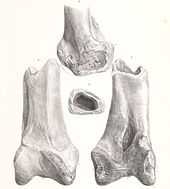Dromornis
| Dromornis Temporal range: Late Miocene - Early Pliocene | |
|---|---|
 | |
| Cast of Dromornis stirtoni from Australia | |
| Scientific classification | |
| Kingdom: | Animalia |
| Phylum: | Chordata |
| Class: | Aves |
| Order: | ?Anseriformes |
| Family: | †Dromornithidae |
| Genus: | †Dromornis Owen, 1872 |
| Species | |
|
†Dromornis australis (type) | |
Dromornis is a genus of prehistoric birds that stood up to 3 metres (10 feet) tall and weighed up to half a ton.
Taxonomy

Although they looked like giant emus, the Dromornis are more closely related to waterfowl. Dromornis are part of a family of giant birds called Dromornithidae that lived from 8 million years ago until less than 30,000 years ago. Australia had been separated from the big southern landmass of Gondwana for millions of years by this time. The animals of Australia had evolved very slowly in almost complete isolation from the animals of other continents. The type specimen, a femur, was found in a 55 metre deep well at Peak Downs, Queensland, and subsequently described by Richard Owen in 1872.[1] Due to the poor fossil record of D. australis (the type species of the genus) and the large time gap between the two Dromornis species, D. stirtoni may eventually be reassigned to the genus Bullockornis.
They are sometimes referred to as Mihirung birds, or the "Stirton's Thunder Birds". 'Mihirung paringmal' is an Aboriginal word from the Tjapwuring people of Western Victoria and it means 'giant bird'.
Description
Dromornis stirtoni was three meters (10 ft) tall and weighed half a ton (500 kg).[1] It was heavier than the Moa and taller than Aepyornis. This genus had a long neck and stub-like wings, rendering it flightless.[2] Its legs were powerful, but it is not believed to have been a fast runner.[2] The bird's beak was large and immensely powerful, leading early researchers to believe that it was used to shear through tough plant stalks.[2] However, recently others have argued that the size of the beak suggests that the bird was a carnivore.[2]
Habitat and behaviour

It inhabited subtropical open woodlands in Australia during the Late Miocene and may have been carnivorous. There were forests and a permanent water supply at Alcoota, one location where the Dromornis birds lived, although the climate was very unpredictable. Dromornis lived in Australia from the late Miocene to the early Pliocene, meaning that early humans never encountered this genus. Dromornis had a huge beak and jaw capable of great force.
Footnotes
References
- Murray, P. F. Vickers-Rich, P. (2004) Magnificent Mihirungs: The Colossal Flightless Birds of the Australian Dreamtime. Indiana University Press. ISBN 978-0-253-34282-9.
- Ellis, R. (2004) No Turning Back: The Life and Death of Animal Species. New York: Harper Perennial. p. 102. ISBN 0-06-055804-0.